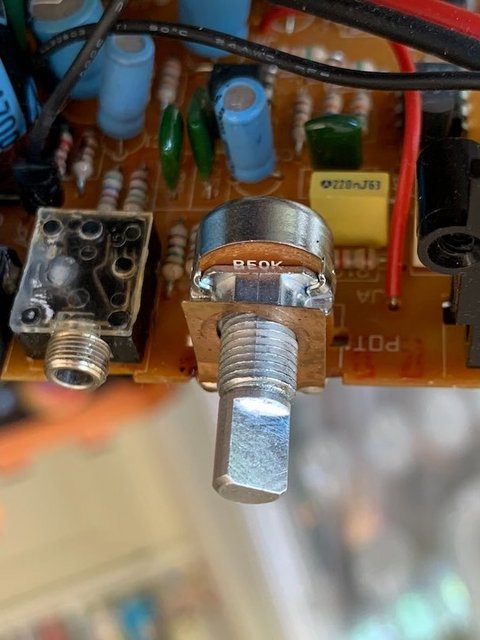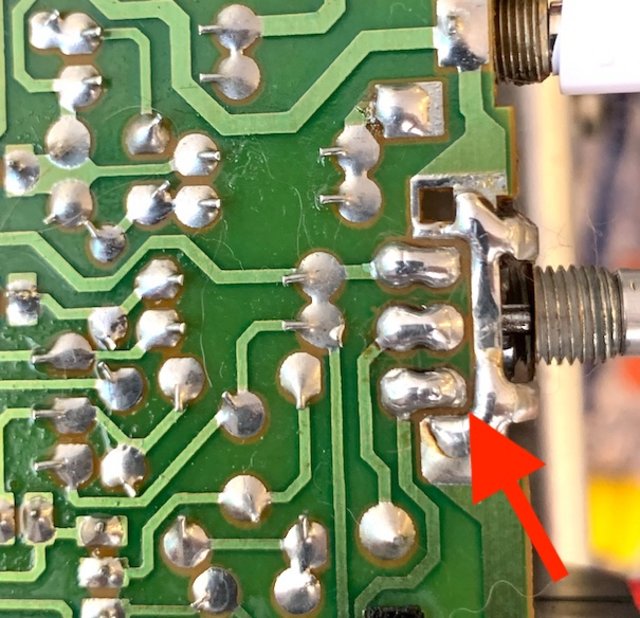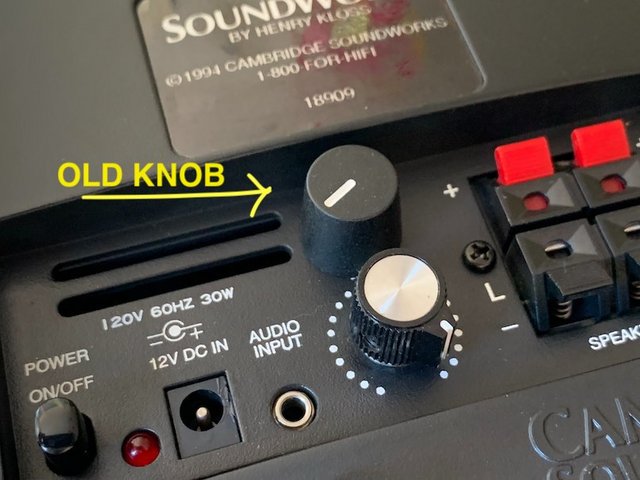We NEED body size caliper measurements (please use mm) and specially pin to pin separation or it will not fit in the PCB
From your picture comparing pins to those of the much larger round one, I measure 3.6mm pin to pin separation.
The one you bought shows 2.5mm so it will NOT fit.
* please confirm hole center to hole center separation at the PCB, first carefully remove broken pot from it, you will need to anyway.
Measure between the most separate ones for better precision.
* just to help in search, please measure square body size, although the measurement you NEED to meet is pin to pin separation.
* matching shaft specs will also help, but as mentioned above is not *that* critical, worst case you use another knob or even leave it bare and twist it with your fingers
EDIT: body "should" be around 11.5mm but please confirm.
Your Mouser shows one of similar size, although with mounting wings and unavailable but confirming case size:
https://www.mouser.com/ProductDetai...KV1-0Y15BR50K?qs=%2BUYXD5bnyXowLs99/3/T%2BQ==
None of the others is even close (16mm or 9mm body)
EDIT2:
Found one matching separation and shaft, body is round but same diameter:
RV120F-20-15F-B50K: Taiwan Alpha : 50k 80mW 5% 0.590" Long "D" Shaft 12mm Linear Taper Potentiometer : Passive Components
from this datasheet, knurled split shaft version seems to be RV120F -20 or -21
https://www.jameco.com/Jameco/Products/ProdDS/2269039.pdf
Difference seems to be hole center to PCB sepration, indicated as H (height?) on dimensional drawing, -20 means 10mm ;-21means 12.5mm
From your picture comparing pins to those of the much larger round one, I measure 3.6mm pin to pin separation.
The one you bought shows 2.5mm so it will NOT fit.
* please confirm hole center to hole center separation at the PCB, first carefully remove broken pot from it, you will need to anyway.
Measure between the most separate ones for better precision.
* just to help in search, please measure square body size, although the measurement you NEED to meet is pin to pin separation.
* matching shaft specs will also help, but as mentioned above is not *that* critical, worst case you use another knob or even leave it bare and twist it with your fingers
EDIT: body "should" be around 11.5mm but please confirm.
Your Mouser shows one of similar size, although with mounting wings and unavailable but confirming case size:
https://www.mouser.com/ProductDetai...KV1-0Y15BR50K?qs=%2BUYXD5bnyXowLs99/3/T%2BQ==
None of the others is even close (16mm or 9mm body)
EDIT2:
Found one matching separation and shaft, body is round but same diameter:
RV120F-20-15F-B50K: Taiwan Alpha : 50k 80mW 5% 0.590" Long "D" Shaft 12mm Linear Taper Potentiometer : Passive Components
from this datasheet, knurled split shaft version seems to be RV120F -20 or -21
https://www.jameco.com/Jameco/Products/ProdDS/2269039.pdf
Difference seems to be hole center to PCB sepration, indicated as H (height?) on dimensional drawing, -20 means 10mm ;-21means 12.5mm
Last edited:
Thanks a million for this JM. So many options.
Caliper shows ≈ 7.5mm pin span between 1st and 3rd pin on board for pot. Height from board mount surface to center of shaft ≈ 9mm, so giving some room for tolerance the 10mm height option "20" looks right. Body is ≈ 12.5 x 12.5mm, with board material holding 3 pins extending downward slightly narrower (≈ 12.1mm).
Total resistance tolerance on the Alpha RV120F-20-15F-B50K is 5%. Seems likely original was 20% based on other Noble pots I've seen, but have no idea. Guessing it will still work since its a lower not a higher tolerance, but could use advice there before pulling the trigger on the "Goldilocks pot" purchase.
Caliper shows ≈ 7.5mm pin span between 1st and 3rd pin on board for pot. Height from board mount surface to center of shaft ≈ 9mm, so giving some room for tolerance the 10mm height option "20" looks right. Body is ≈ 12.5 x 12.5mm, with board material holding 3 pins extending downward slightly narrower (≈ 12.1mm).
Total resistance tolerance on the Alpha RV120F-20-15F-B50K is 5%. Seems likely original was 20% based on other Noble pots I've seen, but have no idea. Guessing it will still work since its a lower not a higher tolerance, but could use advice there before pulling the trigger on the "Goldilocks pot" purchase.
Last edited:
That Alpha pot seems to fit the bill, and to boot is higher precision, althoughn20% is fine .
Being PCB mounted forces you to match pin to pin separation (7.5mm/2~3.8mm so that´s fine) and PCB to shaft center, 9mm you measured is close enough to available 10mm.
Now you have to hunt for one, easier knowing thbe exact spec.
Just as a Plan B, *absolute* worst case is to get any pot that fits, even the 9mm one you already got, mount it rotated 180 degrees so pins face *away* from PCB and wire pins to matching holes with short pieces of wire.
Being PCB mounted forces you to match pin to pin separation (7.5mm/2~3.8mm so that´s fine) and PCB to shaft center, 9mm you measured is close enough to available 10mm.
Now you have to hunt for one, easier knowing thbe exact spec.
Just as a Plan B, *absolute* worst case is to get any pot that fits, even the 9mm one you already got, mount it rotated 180 degrees so pins face *away* from PCB and wire pins to matching holes with short pieces of wire.
Good to know about the wire up solution. I tried finding a better option than the linked Alpha Taiwan pot link you provided, and couldn’t find a closer match. It has a 7.5mm span on the outside pins too. Other than trying to get a knurled shaft (which is an option on that pot but couldn’t find it stocked anywhere) and a more audiophile grade quality (e.g., PEC, Noble ?), seemed there wasn’t anything else to improve from the linked pot.
So Alpha pot has a 6mm d-shaft and got a 1/4 shaft ready knob with a set screw, since my old knob won’t work. I should get the parts in about a week and can’t wait to put this thing back together. Thanks again for the help will post the outcome.
So Alpha pot has a 6mm d-shaft and got a 1/4 shaft ready knob with a set screw, since my old knob won’t work. I should get the parts in about a week and can’t wait to put this thing back together. Thanks again for the help will post the outcome.
Soldered in the pot, put a new knob on, and sounded good for about 15 mins and now getting crackling/popping from the subwoofer, even with no audio source plugged in. Also a little subwoofer buzzing/hum during any turning of the new pot. Sound is fine coming through small stereo speakers connected by L/R speaker jacks.
Have no idea what's causing the issue. It's too bad because really happy with the look of it... better than original IMO.
Any ideas as to cause of sound issues?



Have no idea what's causing the issue. It's too bad because really happy with the look of it... better than original IMO.
Any ideas as to cause of sound issues?



2 possible causes:
1) some cracked track/solder nearby, or maybe some partially pulled connector or similar "poor contact" issue, have a detailed look all around under good light and stacking a couple reading glasses to get real close.
Also maybe *another* pot is misbehaving.
2) check you do not have DC across new pot legs, you might have a leaky capacitor feeding it or it might feed , say, an OpAmp pin which developed offset voltage.
Not much needed to make noise.
meaning: not necessarily new pot is making noise, but it was not noticed before (or was disregarded) because you had a larger problem to solve.
1) some cracked track/solder nearby, or maybe some partially pulled connector or similar "poor contact" issue, have a detailed look all around under good light and stacking a couple reading glasses to get real close.
Also maybe *another* pot is misbehaving.
2) check you do not have DC across new pot legs, you might have a leaky capacitor feeding it or it might feed , say, an OpAmp pin which developed offset voltage.
Not much needed to make noise.
meaning: not necessarily new pot is making noise, but it was not noticed before (or was disregarded) because you had a larger problem to solve.
Success! There was a lot of residue from my amateur soldering job around the pot and audio-in jack reflow. Presumably it was flux residue, which is visible in my prior post with pics. Using a Q-Tip, Xacto knife, and DeoxIT D5, once I cleaned the channel below the crackling went away. I guess the flux residue was conductive to a certain degree.
Thanks JM and all for all the help, very much appreciated. What I thought would be an easy fix became a learning experience and a challenge to keep this speaker from the junk pile after 25 yrs of use.
By the way, at the bottom you can see prior knob against new one. I think it looks better than OEM's version!


Thanks JM and all for all the help, very much appreciated. What I thought would be an easy fix became a learning experience and a challenge to keep this speaker from the junk pile after 25 yrs of use.
By the way, at the bottom you can see prior knob against new one. I think it looks better than OEM's version!


Last edited:
- Status
- This old topic is closed. If you want to reopen this topic, contact a moderator using the "Report Post" button.
- Home
- Design & Build
- Construction Tips
- Type of Pot Needed